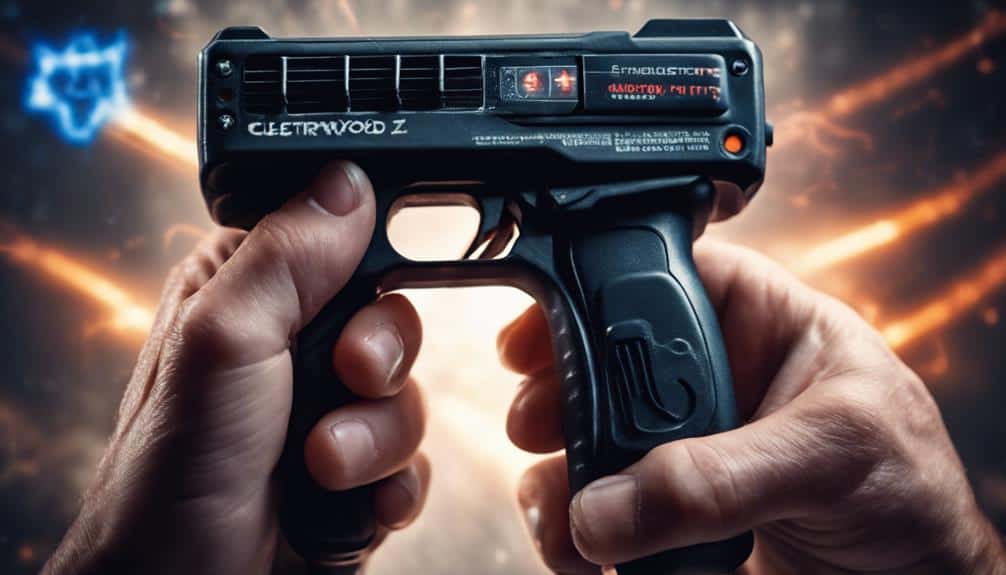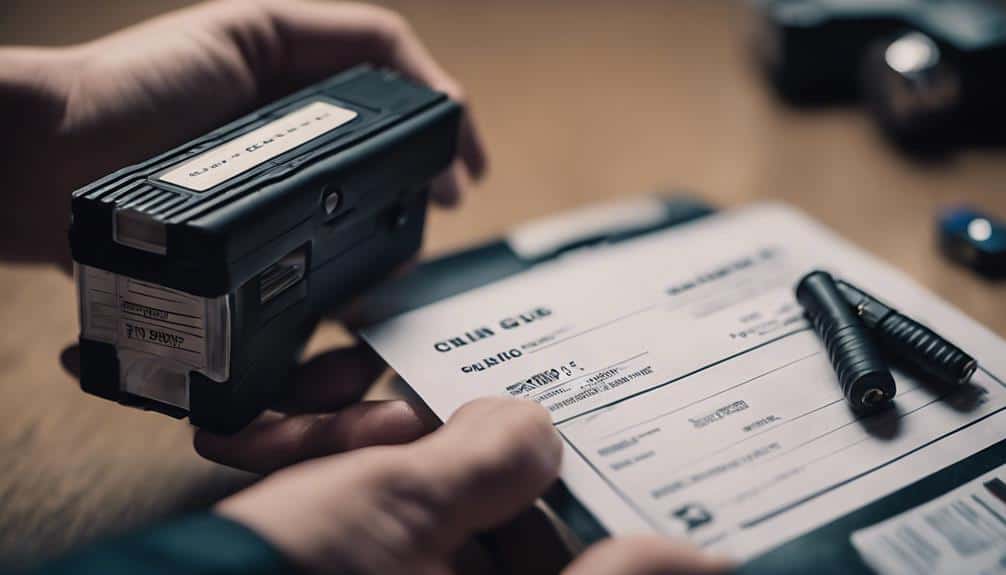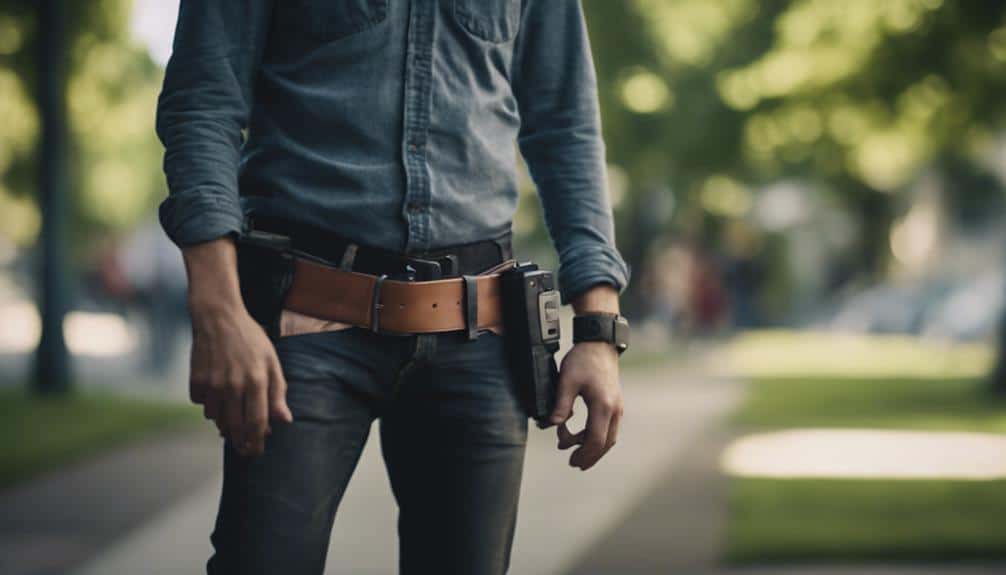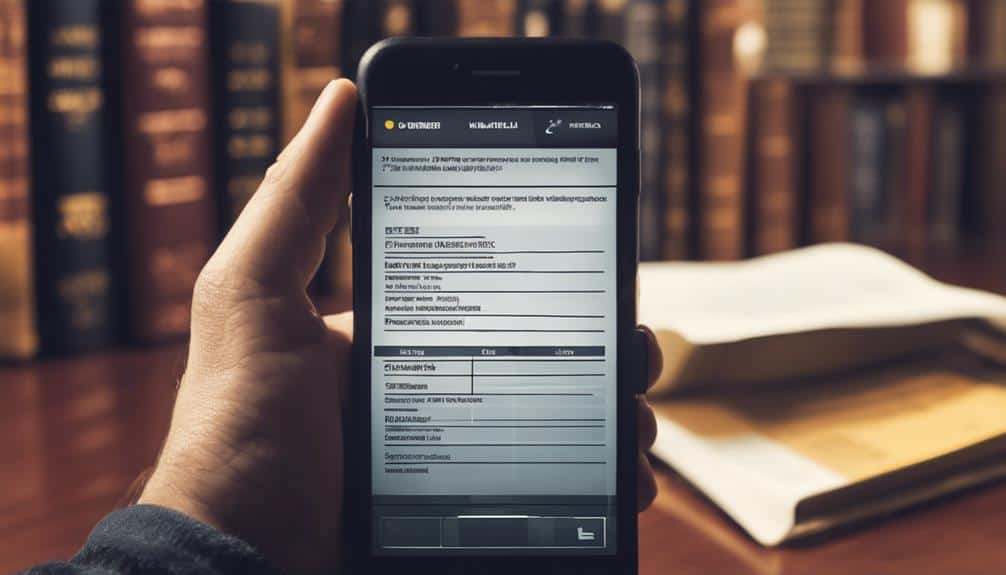How to Legally Carry and Use Mini Stun Guns Safely
To legally and safely carry a mini stun gun, you’ve got to know the ropes. First, check your state and local laws; for example, Rhode Island bans them outright while New York and Connecticut need permits. Avoid government buildings and schools, and know that it’s illegal to zap a law enforcement officer. Safeguard it away from kids, maybe tucked in a secure spot in your car, and regularly test the battery. When in use, aim for effective areas like the torso or neck, and don’t forget – a 3-5 second zap does the trick. Knowledge is power, and the more you know, the better prepared you’re.
 To effectively use a mini stun gun, you’ve got to understand its basic functions and mechanics. Stun guns are non-lethal self-defense devices designed to deliver high voltage electric shocks, temporarily incapacitating an attacker. Think of them as your personal safety net, providing a vital moment to escape a dangerous situation.
When it comes to ownership and use, it’s important to know that stun guns are legal in 49 states, but the rules can vary greatly. Before you purchase one, make sure to check your local and state regulations to stay on the right side of the law. Most states require you to be at least 18 years old to own a stun gun, and some restrict ownership for individuals with felony convictions.
Understanding how to use your stun gun effectively is key. Proper training involves familiarizing yourself with its target areas, such as the neck, torso, and groin, to maximize its impact. Remember, the goal isn’t to cause permanent harm but to create enough confusion and pain for a safe escape.
To effectively use a mini stun gun, you’ve got to understand its basic functions and mechanics. Stun guns are non-lethal self-defense devices designed to deliver high voltage electric shocks, temporarily incapacitating an attacker. Think of them as your personal safety net, providing a vital moment to escape a dangerous situation.
When it comes to ownership and use, it’s important to know that stun guns are legal in 49 states, but the rules can vary greatly. Before you purchase one, make sure to check your local and state regulations to stay on the right side of the law. Most states require you to be at least 18 years old to own a stun gun, and some restrict ownership for individuals with felony convictions.
Understanding how to use your stun gun effectively is key. Proper training involves familiarizing yourself with its target areas, such as the neck, torso, and groin, to maximize its impact. Remember, the goal isn’t to cause permanent harm but to create enough confusion and pain for a safe escape.
 Steering through the permit requirements for mini stun guns can feel like a quest, but it’s essential for staying on the right side of the law.
While most states don’t require a permit, local ordinances might throw a curveball, so always check for specific rules in your area.
Imagine thinking you’re good to go, only to find out your city has stricter regulations—don’t let that be you!
Steering through the permit requirements for mini stun guns can feel like a quest, but it’s essential for staying on the right side of the law.
While most states don’t require a permit, local ordinances might throw a curveball, so always check for specific rules in your area.
Imagine thinking you’re good to go, only to find out your city has stricter regulations—don’t let that be you!
 To guarantee you’re carrying your mini stun gun safely, it’s important to adopt practices that minimize risks and comply with legal requirements. First off, always keep your stun gun securely stored, especially out of reach of children. The final thing you want is a curious kid turning a self-defense tool into a toy!
Next, familiarize yourself with local laws regarding stun guns. Some areas might have specific restrictions on where and how they can be carried. For example, when transporting your mini stun gun in a vehicle, make sure it’s stored in a way that complies with state and local laws, typically in the glove compartment or a secure location.
Avoid carrying your stun gun in prohibited areas like schools, government buildings, and places of worship. Trust me, the legal issues and penalties aren’t worth the hassle. Lastly, regularly check the battery and functionality to guarantee it’s ready for use when needed. After all, a non-functioning stun gun won’t do you much good in a pinch!
Here’s a quick reference table for safe carrying practices:
To guarantee you’re carrying your mini stun gun safely, it’s important to adopt practices that minimize risks and comply with legal requirements. First off, always keep your stun gun securely stored, especially out of reach of children. The final thing you want is a curious kid turning a self-defense tool into a toy!
Next, familiarize yourself with local laws regarding stun guns. Some areas might have specific restrictions on where and how they can be carried. For example, when transporting your mini stun gun in a vehicle, make sure it’s stored in a way that complies with state and local laws, typically in the glove compartment or a secure location.
Avoid carrying your stun gun in prohibited areas like schools, government buildings, and places of worship. Trust me, the legal issues and penalties aren’t worth the hassle. Lastly, regularly check the battery and functionality to guarantee it’s ready for use when needed. After all, a non-functioning stun gun won’t do you much good in a pinch!
Here’s a quick reference table for safe carrying practices:
 Knowing how to use a mini stun gun effectively is only part of the equation; understanding the legal framework governing its use is equally important. You need to be aware of the specific laws in your state regarding the legal use of stun guns for self-defense. Most states allow you to carry and use these devices if you’re at least 18 years old. However, local regulations can vary, so check your area’s specific rules.
If you live in a state with Stand Your Ground laws, like Texas, you can use a stun gun in self-defense if you reasonably believe you’re in imminent danger. However, proper training is essential to guarantee you can deploy it effectively without facing legal repercussions.
Knowing how to use a mini stun gun effectively is only part of the equation; understanding the legal framework governing its use is equally important. You need to be aware of the specific laws in your state regarding the legal use of stun guns for self-defense. Most states allow you to carry and use these devices if you’re at least 18 years old. However, local regulations can vary, so check your area’s specific rules.
If you live in a state with Stand Your Ground laws, like Texas, you can use a stun gun in self-defense if you reasonably believe you’re in imminent danger. However, proper training is essential to guarantee you can deploy it effectively without facing legal repercussions.
Misuse of a stun gun, such as using it during a crime or against law enforcement, can lead to severe consequences. As a result, familiarize yourself with state-specific laws and local ordinances before carrying a mini stun gun to avoid potential legal pitfalls.
 Staying updated on stun gun laws guarantees you remain compliant and avoid legal issues. Stun guns are legal in many places, but state and local regulations regarding their use can vary considerably. To make sure you’re always in the clear, you need to pay attention to these differences and adjust your actions accordingly.
First, check out these three key steps to stay informed:
Staying updated on stun gun laws guarantees you remain compliant and avoid legal issues. Stun guns are legal in many places, but state and local regulations regarding their use can vary considerably. To make sure you’re always in the clear, you need to pay attention to these differences and adjust your actions accordingly.
First, check out these three key steps to stay informed:
Understanding Stun Gun Basics

State Laws and Regulations
Maneuvering through the state laws and regulations surrounding mini stun guns is essential for responsible and legal ownership. You don’t want to find yourself in hot water simply because you didn’t do your homework. Possession of stun guns is legal in 49 states, but each state has its own nuances that you need to look out for. Rhode Island, for example, is the oddball where owning one is outright prohibited. To make sure you’re on the right side of the law, here are three things to keep in mind:- State Laws: Most states don’t require a permit to own or carry mini stun guns, but some, like New York, have specific conditions. Check your state’s regulations before making any assumptions.
- Local Ordinances: Even if your state gives a thumbs-up, local ordinances might throw a wrench in your plans. Cities or counties can have their own rules, so always double-check.
- Restricted Areas: Certain places are off-limits for carrying mini stun guns. Schools, correctional facilities, and public events often have strict no-weapons policies.
Permit Requirements

State Permit Regulations
Understanding state permit regulations is vital when you’re considering carrying a mini stun gun. While most states don’t require a permit, it’s important to know the specific rules where you live. After all, you want to be certain it’s legal to purchase and carry your device without any hassle. In states like Connecticut and Florida, there may be extra hoops to jump through, including needing a permit for certain types of stun devices. Don’t worry, though—it’s all manageable with a bit of research. Generally, you must be at least 18 years old to own and carry a mini stun gun, so if you’re younger, it’s a no-go. Here are three things to keep in mind:- Check state permit regulations: Confirm you’re compliant with your state’s rules.
- Understand local laws: Some regions have stricter ordinances, so double-check.
- Beware of restrictions: Using a stun gun on law enforcement is illegal everywhere, regardless of permits.
Local Ordinance Compliance
When carrying a mini stun gun, it’s essential to check local ordinances for any additional restrictions or permit requirements. Local ordinance compliance isn’t just a good idea—it’s a necessity. While state laws might give you the green light, some municipalities can add their own twist. For instance, your city might demand that you register your stun gun with local law enforcement, even if the state doesn’t. Imagine thinking you’re all set, only to find out you’re on the wrong side of the law. Not fun, right? Regarding possession, you’ll also need to verify minimum age requirements. Some places might set the bar higher (or lower) than state guidelines. And don’t forget about those sneaky ‘gun-free’ zones. Schools, government buildings, and certain public areas might be off-limits for your mini stun gun. You don’t want to get caught unaware in these areas; the fines or criminal charges are no joke.Prohibited Areas
Being aware of prohibited areas for carrying mini stun guns is essential to avoid legal trouble and guarantee responsible usage. Different states and localities have specific regulations that define where stun guns can and can’t be carried, and violating these can lead to serious legal consequences. For instance, in Texas, you can’t bring your mini stun gun onto school property, into correctional facilities, or certain public events, including places of worship. To help you navigate these rules, here are three key areas where you should never carry your mini stun gun:- Government Buildings: Many states have laws prohibiting stun guns in government buildings. Always check the local regulations before you go.
- Public Gatherings: Carrying a stun gun at large public events or gatherings is often illegal. It’s best to leave it at home when attending concerts or festivals.
- Designated City Areas: Some cities and counties have additional restrictions, so it’s vital to be aware of local regulations in your area.
Safe Carrying Practices

| Practice | Description |
|---|---|
| Secure Storage | Keep out of reach of children |
| Familiarize with Local Laws | Know restrictions for carrying and transporting |
| Vehicle Transport | Store in glove compartment or secure location |
| Avoid Prohibited Areas | Don’t carry in schools, government buildings, places of worship |
Proper Usage Techniques
Mastering proper usage techniques for mini stun guns guarantees you can incapacitate an assailant effectively and safely. When you’re faced with an emergency, it’s essential you know exactly what to do. First, aim for the right areas. Target zones such as the upper hips, upper shoulders, and below the rib cage maximize the stun gun’s effectiveness. Don’t waste time zapping an attacker’s arm or leg; go for the areas that count! Second, remember the time factor. A brief 3 to 5-second application is usually enough to temporarily immobilize an assailant, giving you the precious seconds needed to escape. Longer isn’t always better—don’t overdo it. Third, and maybe the most important to note, familiarize yourself with your stun gun’s features. This includes knowing the safety switch to avoid accidental discharges and regularly checking the battery to confirm it’s operational when you need it most. Here’s a quick rundown:- Aim for Target Areas: Upper hips, upper shoulders, and below the rib cage.
- Time It Right: 3 to 5 seconds is usually sufficient.
- Know Your Device: Understand the safety features and keep it operational.
Legal Use in Self-Defense

| State | Age Requirement | Stand Your Ground Law |
|---|---|---|
| Texas | At least 18 | Yes |
| California | At least 18 | No |
| Florida | At least 18 | Yes |
Penalties for Misuse
Misusing a mini stun gun can land you in hot water, with penalties ranging from fines to jail time depending on where you live and the severity of the misuse. For example, using a stun gun during a crime in Texas isn’t just a bad idea—it’s illegal and can stack additional penalties onto your sentence. To avoid becoming a cautionary tale, always know your local laws and use your stun gun responsibly, ensuring it’s only for self-defense, not to settle a parking dispute!Legal Consequences Overview
Misusing a stun gun can lead to severe criminal charges, including fines, community service, or imprisonment. If you think owning a stun gun is as simple as just having it for self-defense, think again. The legal consequences can be quite serious if you misuse it. Understanding the legal consequences of stun gun ownership is essential. Here’s what you need to know:- Using During a Crime: If you use a stun gun while committing a crime, you could face felony charges. This means hefty fines and possibly years behind bars.
- Selling to Minors or Felons: In states like Texas, selling or leasing a stun gun to minors or convicted felons is illegal and can result in significant penalties. Imagine explaining that mistake to a judge!
- Restricted Areas: Possessing a stun gun on school grounds or in correctional facilities is strictly prohibited. Violating these restrictions can lead to serious legal trouble, including jail time.
Responsible Usage Practices
To guarantee you avoid legal penalties, it’s essential to use a mini stun gun responsibly and in accordance with local laws. Misusing a stun gun, whether during a crime or against law enforcement, can land you in hot water faster than you can say ‘Texas Penal Code Section 46.05.’ You could be staring down misdemeanor or even felony charges, with penalties ranging from hefty fines to community service, or worse, imprisonment. Not exactly a fun way to spend your weekends, right? Legal ownership of a stun gun comes with the responsibility to be at least 18 years old. Using it against someone younger could spell additional legal nightmares. And whatever you do, always report any self-defense incidents involving your stun gun to the authorities. Failing to do so might raise eyebrows and legal concerns about whether your actions were justified. It’s also important to familiarize yourself with local ordinances, as some areas have stricter regulations on stun gun usage. Ignorance isn’t bliss here—it’s a quick route to more legal penalties.Staying Updated on Laws

- Regularly Review State and Local Laws: Laws change, so make it a habit to review your state and local regulations every few months. Some states require you to be at least 18 years old, while others may have restrictions based on your criminal history.
- Understand Local Ordinances: Even if your state allows stun guns, local ordinances might impose stricter rules. For example, a city might have specific restrictions on where you can carry a stun gun, so always double-check.
- Stay Informed About Self-Defense Laws: The use of stun guns for self-defense can differ by jurisdiction. Some places only allow their use in imminent threat situations, so know the specifics to avoid any legal trouble.
Frequently Asked Questions
Can You Bring a Stun Gun in Your Carry On?
No, you can’t bring a stun gun in your carry-on. TSA regulations prohibit it due to stun gun safety concerns. Consider stun gun alternatives if you need self-defense options while traveling. Always follow stun gun regulations.Where Is the Most Effective Place to Use a Stun Gun?
To guarantee the best practices in self-defense scenarios, target the upper hips, upper shoulders, and below the rib cage with your stun gun. Be aware of legal restrictions and use these areas to maximize effectiveness.Do You Need a License to Carry Around a Taser?
You don’t need a license to carry a TASER in most states, but taser regulations and self-defense laws vary. Always check local laws to verify you’re compliant and prioritize personal safety when carrying one.Do I Need a License to Carry a Stun Gun in Texas?
You don’t need a license to carry a stun gun in Texas. However, make sure you follow stun gun regulations, self-defense laws, and carrying guidelines. Verify local rules to avoid any issues with municipal regulations.
Facebook
Twitter
LinkedIn
Pinterest

